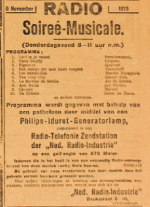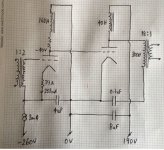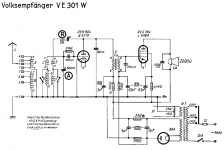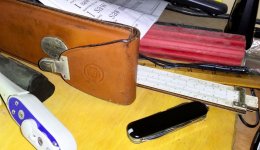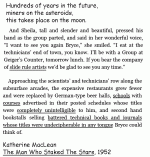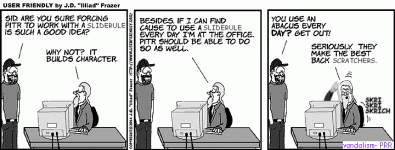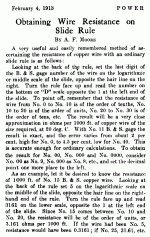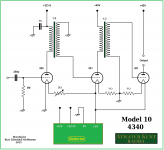Its interesting to see comment on old valve/tube equipment and claims made .
This is straight from Mazda /Cossor UK valve manufacturers official engineering manual-
A valve -The words first valve for commercial sale -1906
AC/HL/DDD -The worlds first Triple-Diode-Triode -1933
DC2/SG/VM-Worlds first range of low consumption (0.1A) valves DC mains valves -1931
QP240-Worlds first double Pentode valve-1933
R-Ediswan GP bright emitter Triode (top pip )-the first quantity produced valve on sale to the public in Britain --- the "R" valve was issued to the British military at the start of WW1 (UK start -1915).
This is straight from Mazda /Cossor UK valve manufacturers official engineering manual-
A valve -The words first valve for commercial sale -1906
AC/HL/DDD -The worlds first Triple-Diode-Triode -1933
DC2/SG/VM-Worlds first range of low consumption (0.1A) valves DC mains valves -1931
QP240-Worlds first double Pentode valve-1933
R-Ediswan GP bright emitter Triode (top pip )-the first quantity produced valve on sale to the public in Britain --- the "R" valve was issued to the British military at the start of WW1 (UK start -1915).
No radio was invented although Marconi was already successfull with its telegraphic demonstrations and that was heavily used by mostly military industry in WW1.
The first regular radio broadcast in the Netherlands started on 6 November 1919 at 8 PM local time, so just over 100 years ago. The first record played on that show was Turf in je ransel. The transmitter was a narrowband FM transmitter, by the way.
Attachments
If you want to really build an oldish amplifier I would suggest the 71A tube. Still around at modest prices!
Agree, but use UX-171 or CX-371 thoriated tungsten version with type 112 as driver, all introduced in 1925.
As it happens, I am currently building this amplifier, see attached (re-size 0.1uF accordingly).
Also in Adelaide.
HK
Attachments
Last edited:
The first regular radio broadcast in the Netherlands started on 6 November 1919 at 8 PM local time, so just over 100 years ago. The first record played on that show was Turf in je ransel. The transmitter was a narrowband FM transmitter, by the way.
OK, the Netherlands were ahead of the Grossdeutsches Reich, but only at this topic! In Germoney the first Deutsche Reichs Rundfunksendung was in October 29th, 1923.
Schmitz you don't happen to have an original Volksempfanger radio do you ?
Introduced in 1933 the "Peoples Radio " was affordable to all-- 76 Reichsmarks unlike here in the UK where wirelesses (radios ) were very expensive at the time even valves (tubes) cost a days wages.
I once owned a Volkswagen Beetle while eventually it started rusting the engine went on forever even started in the dead of winter (air cooled ) .
It wasn't until the 1940,s that Britain produced a cheap "wartime radio " and boy !! wasn't it cheaply made .I have one it looks like something a schoolboy has cobbled up at a carpentry course.
Introduced in 1933 the "Peoples Radio " was affordable to all-- 76 Reichsmarks unlike here in the UK where wirelesses (radios ) were very expensive at the time even valves (tubes) cost a days wages.
I once owned a Volkswagen Beetle while eventually it started rusting the engine went on forever even started in the dead of winter (air cooled ) .
It wasn't until the 1940,s that Britain produced a cheap "wartime radio " and boy !! wasn't it cheaply made .I have one it looks like something a schoolboy has cobbled up at a carpentry course.
"The first model, VE (Volksempfänger) 301, was presented in August 1933 at the radio exhibition in Berlin. The designation 301 is said to refer to January 30, 1933, the day the National Socialists seized power. The device had a bakelite housing and all major German radio manufacturers were obliged to produce the people's receiver according to uniform specifications. This also affected the price, which was 76 Reichsmark for the version of the VE 301 that was operated on the power grid. The battery-powered version cost 65 Reichsmarks."
I saw a lot of those tiny poor bakelite radios but always had the need for the more luxurious models. The tubes were excellent, but the circuit was so stripped to the bone that it could be produced cheap enough to win the war still. It couldn't detect UKW, just middle waves with a lot of noise.
Beetles were the iAuto for the masses until the 1980's here in germany. So you can see how Mr. Porsches success design had a strong influence on motor traffic even forty years after WW2.
The brits won't believe this car will ever be a success so they left the Wolfsburg production site undestroyed. They couldn't have been more wrong. Porsche was a genious.
And remember, the Deutsches Reich invented the Pentode, because the emperor took a tax on every single tube used in a reveiver. So the germans tried to minimize its number.
I saw a lot of those tiny poor bakelite radios but always had the need for the more luxurious models. The tubes were excellent, but the circuit was so stripped to the bone that it could be produced cheap enough to win the war still. It couldn't detect UKW, just middle waves with a lot of noise.
Beetles were the iAuto for the masses until the 1980's here in germany. So you can see how Mr. Porsches success design had a strong influence on motor traffic even forty years after WW2.
The brits won't believe this car will ever be a success so they left the Wolfsburg production site undestroyed. They couldn't have been more wrong. Porsche was a genious.
And remember, the Deutsches Reich invented the Pentode, because the emperor took a tax on every single tube used in a reveiver. So the germans tried to minimize its number.
Last edited:
I still don't have the UK wartime civilian receiver on my collection, but I once tried to use my 1933 VE301W Volksempfanger as computer speaker. The audio quality is suprisingly good, for a device of this kind and age. There is a very noticeable hum, and high frequencies are muffled, but music reproduction is markedly better than the average compact inexpensive portable bluetooth speakers of today. Maybe even marginally better than the built-in speaker of some TV sets. This is a bit sad, in a sense.
Hooking up the VE301W to a standard audio source is very easy and totally reversible. Just remove the RF tube REN904 and connect the audio source on the tube socket with standard mini banana plugs. A 630V capacitor must be connected in series with the audio signal. This cheap radio has a true power transformer, so the chassis is safe to touch. It does even have a mains fuse: a far more safe design compared to USA midget radios of the same period.
The first Volksempfanger is collectible also because the cabinet was the work of a industrial designer; it was very modern and the shape is still peculiar and interesting. The radio part instead was old fashioned and low performing - this was probably a deliberate decision. I am unable to receive any radio on my specimen despite a 3m wire as antenna. The VE301W was followed after a few years by a smaller and cheaper version with dynamic speaker. This smaller later type is the most common one.
Hooking up the VE301W to a standard audio source is very easy and totally reversible. Just remove the RF tube REN904 and connect the audio source on the tube socket with standard mini banana plugs. A 630V capacitor must be connected in series with the audio signal. This cheap radio has a true power transformer, so the chassis is safe to touch. It does even have a mains fuse: a far more safe design compared to USA midget radios of the same period.
The first Volksempfanger is collectible also because the cabinet was the work of a industrial designer; it was very modern and the shape is still peculiar and interesting. The radio part instead was old fashioned and low performing - this was probably a deliberate decision. I am unable to receive any radio on my specimen despite a 3m wire as antenna. The VE301W was followed after a few years by a smaller and cheaper version with dynamic speaker. This smaller later type is the most common one.
Attachments
Its internals were intentionally stripped down to stop reception of radio signals from the UK but with a long aerial in the evening it could be picked up.
There was also a "Peoples Fridge " , I actually admire German engineering watch all the engineering programmes on German satellite -Astra 19 E and German documentaries have now surpassed British ones -- no loud background music , no third rate "personality " promoting themselves just facts .
In the 1930,s all the workers were given paid holidays abroad (Italy popular ) and then you have Motorways -Autobahn--Reichsautobahn watched the first ones built in Europe being constructed.
Also the Bundestag (German Reich) pays for new films for the German people to watch --here we pay through the nose for the same.
There was also a "Peoples Fridge " , I actually admire German engineering watch all the engineering programmes on German satellite -Astra 19 E and German documentaries have now surpassed British ones -- no loud background music , no third rate "personality " promoting themselves just facts .
In the 1930,s all the workers were given paid holidays abroad (Italy popular ) and then you have Motorways -Autobahn--Reichsautobahn watched the first ones built in Europe being constructed.
Also the Bundestag (German Reich) pays for new films for the German people to watch --here we pay through the nose for the same.
And remember, the Deutsches Reich invented the Pentode, because the emperor took a tax on every single tube used in a reveiver. So the germans tried to minimize its number.
Don't you mean the integrated circuit: Loewe multi-valves The pentode was invented in 1926 by the Dutchmen Bernard Tellegen and Gilles Holst.
Introduced in 1933 the "Peoples Radio " was affordable to all-- 76 Reichsmarks unlike here in the UK where wirelesses (radios) were very expensive at the time even valves (tubes) cost a days wages.
Yes, everyone in Germany had to be able to listen to Hitler's speeches.
My point Marcel was that it took Britain another 10 years to introduce a very cheap radio and that was for the same reason as the German radio introduction listen to Churchill,s speech,s.
The one shown below is the one I have only mine is in worse condition -
painted dial (stations inked in ) 4 valves instead of five and look at the price still very expensive compared to the German version .
Civilian Wartime Utility Radio Receiver - Radio WorkshopRadio Workshop
The German radio was a "work of art " compared to mine.
The one shown below is the one I have only mine is in worse condition -
painted dial (stations inked in ) 4 valves instead of five and look at the price still very expensive compared to the German version .
Civilian Wartime Utility Radio Receiver - Radio WorkshopRadio Workshop
The German radio was a "work of art " compared to mine.
I have 4 UY224 tubes, was thinking they would make a good preamp. First tetrode tube that came out around 1927. Any comments on these tubes?
Although meant for RF/IF they dont seem to be VM (variable mu) so would work but the gain is very low -0.8 ma/v.
UY base -USA 5pin.
UY base -USA 5pin.
I would like to suggest to use a 100 year old amplifier schematic, but with more modern, and hence more accessible parts, provided they are of the same kind as the original. This means, if the circuit uses a triode, use a triode, but one that is more accessible.
This should reduce the cost.
This should reduce the cost.
Last edited:
-Slide rule calculations allowed
Slide rule still used here. Attached picture taken today.
The filthy Acu-Design (Chavez-Roos) is a bit wobbly but fine for electronics. The leather-holstered Dietzgen was a fine stick but someone broke it and glued a face on WRONG. And is really more stick than I need.
When George was born Katherine wrote a sci-fi where the techs on the moon use slide rules and battered 2nd-hand books.
Attachments
The first commercial amplifier tube mass produced was probably the RCA UV201 actually made by General Electric. It was available in 1920.....
The Audion of 1906 was both a detector and an amplifier.
By today's standards, not too good at either job, but that's history.
DeForest Spherical Audion
Slide rule still used here.
I used to leave one on my desk at work to confuse the young engineers. It got lost somewhere, but once they put the scientific calculator in Windows, I had quit using it. I never needed anything more powerful to do my engineering job.....all that complex math.....that's for the guys who WRITE the simulator code....I just feed it information and roll the dice. That and PC board layout are REAL video games.
Anyone remember the round slide rules. Some had "one lap" scales, but some had spirals that made several laps around the slide rule for better accuracy. I remember a big one with some white and yellow scales that were equal to a linear slide rule several feet long.
I found this schematic of one of the first commercial amps on the market in the 1920s. I would be interest to hear some comments on how this amp may sound / function. It looks like it would be expensive to build based on the inter-stage transformers. There really isn't much to it.
Attachments
Much of the signal gain is being done by the transformers? It looks like they were designed for gain as well as coupling? This has to be a very expensive high end transformer for a modern hifi response curve. i Realize this was not a design consideration 100 years ago. This is no longer done because caps are much cheaper and tubes are better today? I have seen some very high end schematics where they boast no caps in the signal path, same simple 100 year old design basically. Usually with 2A3 or 300B, but when I look up the transformers used they are VERY expensive.
- Home
- Amplifiers
- Tubes / Valves
- 100 year old amplifier.
